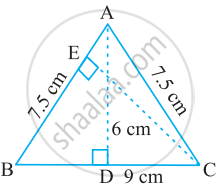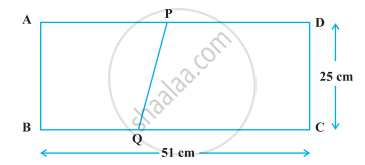Advertisements
Advertisements
Question
In the given figure, if PR = 12 cm, QR = 6 cm and PL = 8 cm, then QM is ______.

Options
6 cm
9 cm
4 cm
2 cm
Solution
In the given figure, if PR = 12 cm, QR = 6 cm and PL = 8 cm, then QM is 4 cm.
Explanation:

Given that, PR = 12 cm, QR = 6 cm and PL = 8 cm
Now, In right angled ΔPLR, using Pythagoras theorem,
(Hypotenuse)2 = (Perpendicular)2 + (Base)2
⇒ PR2 = PL2 + LR2
⇒ LR2 = PR2 – PL2 = (12)2 – (8)2
⇒ LR2 = 144 – 64 = 80
⇒ LR = `sqrt(80) = 4sqrt(5)` cm
∵ LR = LQ + QR
⇒ LQ = LR – QR = `(4sqrt(5) - 6)` cm
Now, area of ΔPLR,
A1 = `1/2 xx LR xx PL`
= `1/2 xx (4sqrt(5)) xx 8`
= `16sqrt(5)` cm2
Again, area of ΔPLQ,
A2 = `1/2 xx LQ xx PL`
= `1/2 xx (4sqrt(5) - 6) xx 8`
= `(16sqrt(5) - 24)` cm2
∴ Area of ΔPLR = Area of ΔPLQ + Area of ΔPQR
⇒ `16sqrt(5) = (16sqrt(5) - 24)` + Area of ΔPQR
⇒ Area of ΔPQR = 24 cm2
⇒ `1/2 xx PR xx QM` = 24
⇒ `1/2 xx 12 xx QM` = 24
∴ QM = 4 cm
APPEARS IN
RELATED QUESTIONS
The perimeter of a right triangle is 60 cm. Its hypotenuse is 25 cm. Find the area of the triangle.
If the points A(x, 2), B(−3, −4) and C(7, − 5) are collinear, then the value of x is:
(A) −63
(B) 63
(C) 60
(D) −60
If the points P(–3, 9), Q(a, b) and R(4, – 5) are collinear and a + b = 1, find the values of a and b.
ΔABC is isosceles with AB = AC = 7.5 cm and BC = 9 cm (see the given figure). The height AD from A to BC, is 6 cm. Find the area of ΔABC. What will be the height from C to AB i.e., CE?

The vertices of ΔABC are (−2, 1), (5, 4) and (2, −3) respectively. Find the area of the triangle and the length of the altitude through A.
Find the value of k so that the area of the triangle with vertices A (k+1, 1), B(4, -3) and C(7, -k) is 6 square units
Using integration, find the area of the triangle whose vertices are (2, 3), (3, 5) and (4, 4).
The value of the determinant `abs((1,"x","x"^3),(1,"y","y"^3),(1,"z","z"^3))` is ____________.
Find the area of the triangle whose vertices are (–8, 4), (–6, 6) and (–3, 9).
The dimensions of a rectangle ABCD are 51 cm × 25 cm. A trapezium PQCD with its parallel sides QC and PD in the ratio 9 : 8, is cut off from the rectangle as shown in the following figure. If the area of the trapezium PQCD is `5/6` th part of the area of the rectangle, find the lengths QC and PD.

